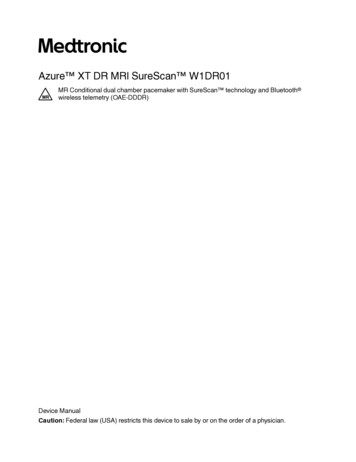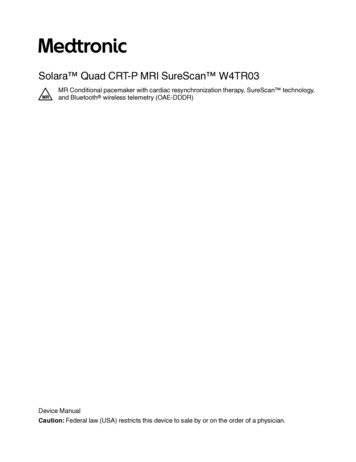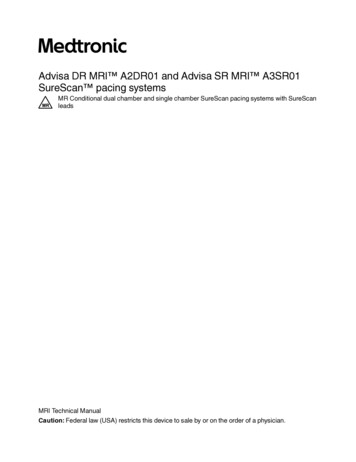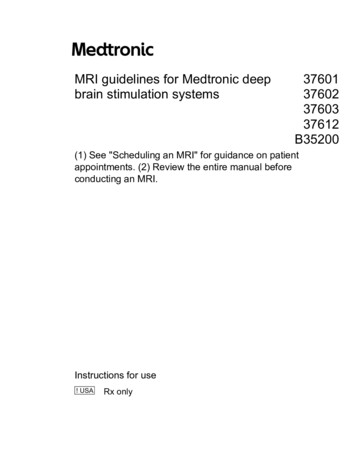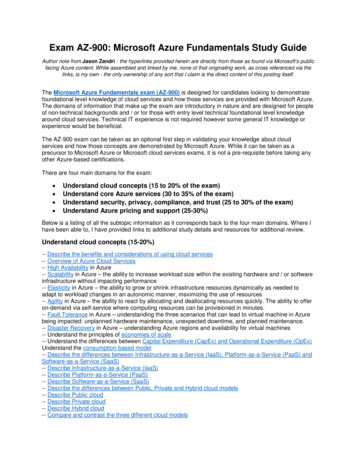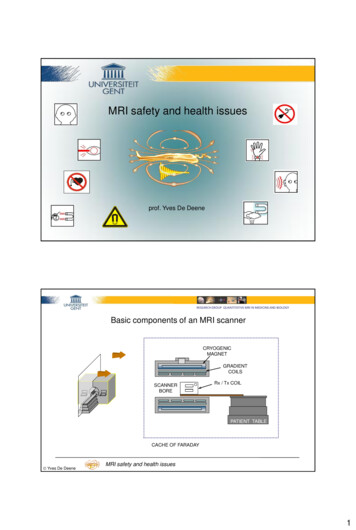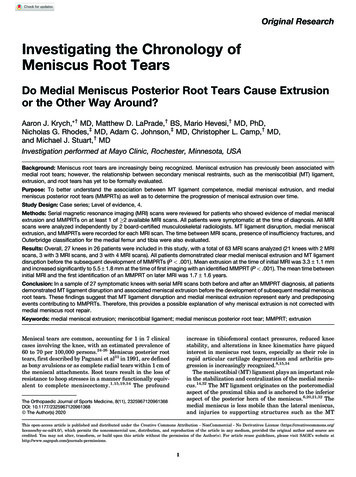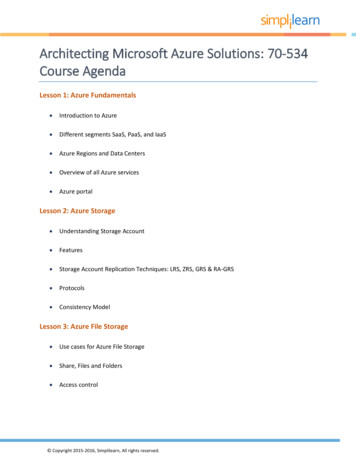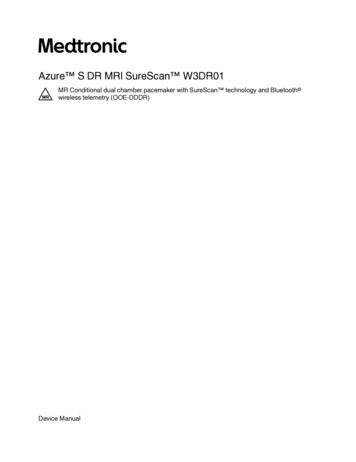
Transcription
Azure S DR MRI SureScan W3DR01MR Conditional dual chamber pacemaker with SureScan technology and Bluetooth wireless telemetry (OOE-DDDR)Device Manual
The following list includes trademarks or registered trademarks of Medtronic in the United States andpossibly in other countries. All other trademarks are the property of their respective owners.Azure, Capture Management, CareAlert, CareLink, Flashback, Medtronic, Medtronic CareAlert,Medtronic CareLink, MVP, Quick Look, SureScan, TherapyGuide
Contents1 System overview 41.11.21.31.41.51.61.71.81.9CE mark of conformity 4Introduction 4System description 4Indications and usage 5Contraindications 5MRI conditions for use 6Feature summary 6Data security 8Pacing mode information 82 Warnings, precautions, and potential adverse events 92.12.22.32.42.52.6General warnings and precautions 9Explant and disposal 9Handling and storage instructions 9Lead evaluation and lead connection 10Device operation 10Potential adverse events 123 Implant procedure 133.13.23.33.43.53.63.7Preparing for an implant 13Selecting and implanting the leads 14Testing the lead system 15Connecting the leads to the device 16Positioning and securing the device 17Completing the implant procedure 18Replacing a device 184 Product specifications 194.14.24.34.4Physical characteristics 19Electrical specifications 20Replacement indicators 23Projected service life 245 Device parameters 265.15.25.35.45.55.65.75.85.9Emergency settings 26Magnet application 26Tachyarrhythmia detection parameters 26Pacing parameters 27Data collection parameters 31Medtronic CareAlert parameters 32System test parameters 33EP study parameters 34Nonprogrammable parameters 363
1 System overview1.1 CE mark of conformity20171.2 IntroductionThis manual describes the Medtronic Model W3DR01 Azure S DR MRI SureScan dual chamber, implantablepulse generator (IPG). It contains model-specific feature information, indications and contraindications, warningsand precautions, instructions for implanting the device, quick reference specifications, and parameter tables.Additional manuals and documents with information about the device:MRI technical manual – This manual provides MRI-specific procedures and warnings and precautions.Reference manual – This manual contains information about device features. The reference manual applies tomultiple models of IPG devices.Programming guide – This manual explains how to use the programmer software to conduct a patient session.Explanation of symbols – This document defines the symbols that may appear on the device package. Refer tothe package label to see which symbols apply specifically to this device.Medical Procedure and EMI Warnings and Precautions Manual for Health Care Professionals – Thismanual provides warnings, precautions, and guidance for health care professionals who perform medicaltherapies and diagnostic procedures on cardiac device patients. The manual also provides patient educationinformation related to sources of electromagnetic interference (EMI) at home, at work, and in other environments.Radio regulatory compliance information – This document provides compliance information related to theradio components of the device.1.3 System descriptionThe Medtronic Azure S DR MRI SureScan Model W3DR01 dual chamber implantable pulse generator (IPG) is amultiprogrammable cardiac device that monitors and regulates the patient’s heart rate by providing single or dualchamber rate-responsive bradycardia pacing. This device features Bluetooth wireless technology.1The MRI SureScan feature permits a mode of operation that allows a patient with a SureScan system to be safelyscanned by an MRI machine while the device continues to provide appropriate pacing. When programmed to On,MRI SureScan operation disables arrhythmia detection, magnet mode, and all user-defined diagnostics. Beforeperforming an MRI scan, refer to the MRI technical manual.Rate response – Rate response is controlled through an activity-based sensor.The users of this device include medical professionals (physicians, nurses, technicians, and their supporting staff)trained in surgery, cardiology, radiology, and magnetic resonance (MR) technology and able to implement theprocedures documented in the instructions for use for this device.1 The Bluetooth word mark is a registered trademark of Bluetooth SIG, Inc. and any use of this mark byMedtronic is under license.4
1.3.1 Usage environmentsThe device is intended to be used in the following environments and conditions: The device will be implanted in a properly equipped, staffed, and sterile surgical environment. Implant will takeplace under standard surgical protocols and in the patient population for which the device is indicated. Post-surgical patient and device follow-up care will take place in a properly equipped and staffed cardiologyclinic or office. MRI procedures for patients with this device will take place in a properly equipped and staffed MR facility, andin consideration of the conditions and requirements described in Section 1.6, “MRI conditions for use”,page 6. After having an implant, patients may resume their lives at home, at work, and in other environments withconsideration of the advice and restrictions documented in the Medical Procedure and EMI Warnings andPrecautions Manual for Health Care Professionals.1.3.2 System components and accessoriesContents of sterile package – The package contains 1 implantable pulse generator (IPG) and 1 torque wrench.Implantable device system – The Azure S DR MRI SureScan Model W3DR01 device and the pacing leadsconstitute the implantable portions of the device system.Leads – The lead system used with this device must provide sensing and pacing to the right ventricle (RV) and tothe atrium (A). Do not use any lead with this device without first verifying lead and connector compatibility.For information about selecting and implanting SureScan leads for this device, refer to Section 3.2, “Selecting andimplanting the leads”, page 14.Programmers and software – Medtronic programmers and software are used to program this device.Programmers from other manufacturers are not compatible with Medtronic devices, but they do not damageMedtronic devices.Medtronic pacing system analyzer – A pacing system analyzer is used to measure the electrical characteristicsof the implanted leads to assess their effectiveness for pacing and sensing.Medtronic patient monitor – Patients use the Medtronic patient monitor, if available, to gather information fromtheir implanted devices and communicate the information to their physicians through the Medtronic CareLinkNetwork. For information on using the patient monitor, refer to the patient monitor literature.1.4 Indications and usageThe Azure S DR MRI SureScan system is indicated for use in patients who may benefit from rate responsive ornon-rate responsive pacing to restore physiologic heart rates, improve cardiac output, prevent symptoms, orprotect against arrhythmias related to cardiac impulse formation or conduction disorders.1.5 ContraindicationsThe Medtronic Azure S DR MRI SureScan system is contraindicated for the following: Concomitant implantation with another bradycardia device Concomitant implantation with an implantable cardioverter defibrillator (ICD) Rate responsive modes in patients who cannot tolerate pacing rates above the programmed lower rate Dual chamber pacing in patients with chronic or persistent supraventricular tachycardias, including atrialfibrillation or flutter Single chamber atrial pacing in patients with an AV conduction disturbance Asynchronous pacing where spontaneous rhythms may cause competitive pacing5
1.6 MRI conditions for useA complete SureScan pacing system is required for use in the MR environment. A complete SureScanpacing system includes a SureScan device with Medtronic SureScan leads. Any other combination mayresult in a hazard to the patient during an MRI scan.Warning: Do not scan a patient without first programming the MRI SureScan mode to On. Scanning the patientwithout programming the MRI SureScan mode to On may result in patient harm or damage to the SureScan pacingsystem.Note: The MRI SureScan mode cannot be programmed to On if the device is recommended for replacement.Cardiology requirementsPatients and their implanted systems must be screened to meet the following requirements: The patient has no implanted lead extenders, lead adaptors, or abandoned leads. The patient has no broken leads or leads with intermittent electrical contact, as confirmed by lead impedancehistory. The SureScan pacing system is implanted in the left or right pectoral region. The pace polarity parameters are set to Bipolar for programming the MRI SureScan mode to On. The SureScan device is operating within the projected service life. For patients whose device will be programmed to an asynchronous pacing mode when the MRI SureScanmode is programmed to On, no diaphragmatic stimulation is present when the paced leads have a pacingoutput of 5.0 V and a pulse width of 1.0 ms.Caution: It is not recommended to perform an MRI scan if the right ventricular (RV) lead pacing capture thresholdis greater than 2.0 V at 0.4 ms for pacemaker-dependent patients. A higher pacing capture threshold may indicatean issue with the implanted lead.Notes: For radiology requirements, refer to the MRI technical manual. Before performing an MRI scan, refer to the MRI technical manual for MRI-specific warnings andprecautions.Patient monitoring and rescue requirements Continuous patient monitoring is required during the MRI scan. In the event that patient rescue is required, an external defibrillator must be immediately available.1.7 Feature summaryThe following features are available in this device. For a list of the features that are enabled at shipping, see the“Shipped” column of the tables in Chapter 5, “Device parameters”, page 26.1.7.1 Pacing featuresAtrial Capture Management – This feature monitors the atrial pacing threshold with daily pacing thresholdsearches and, if programmed to do so, adjusts the atrial pacing amplitude toward a target amplitude.Atrial Preference Pacing (APP) – The system provides an overdrive pacing technique designed to counteractpotential atrial tachyarrhythmia initiating mechanisms. APP maintains a consistent activation sequence byproviding continuous pacing that is slightly higher than the intrinsic rate.Auto-adjusting sensitivity – This feature automatically adjusts the sensitivity thresholds after specific pacedevents and sensed events occur.Automatic polarity configuration – This device uses lead impedance measurements to automatically configurepacing and sensing polarities during Implant Detection.6
Automatic PVARP – This feature adjusts PVARP (Post-Ventricular Atrial Refractory Period) in response tochanges in the patient’s heart rate or pacing rate. PVARP is longer at lower tracking rates to preventpacemaker-mediated tachycardia (PMT) and shorter at higher rates to maintain 1:1 tracking.Mode Switch – This feature switches the device from a tracking mode to a nontracking mode to prevent rapidventricular pacing that may result from a high atrial rate, and restores the programmed pacing mode when the atrialtachyarrhythmia ends.MRI SureScan – This feature allows patients with an implanted MRI SureScan system, including the device andleads, to have a safe MRI procedure if the requirements provided in the MRI technical manual are followed.MVP (Managed Ventricular Pacing) – The MVP feature promotes intrinsic conduction by reducing unnecessaryright ventricular pacing. This feature operates when the programmed mode is either AAIR DDDR orAAI DDD.Non-Competitive Atrial Pacing (NCAP) – This feature prevents pacing the atrium too soon after a refractoryatrial sense by delaying the scheduled atrial pace.Pacemaker-mediated Tachycardia (PMT) Intervention – This feature provides automatic detection andinterruption of device-defined PMTs.PVC Response – This feature extends PVARP following a premature ventricular contraction (PVC) to avoidtracking a retrograde P-wave and to prevent retrograde conduction from inhibiting an atrial pace.Rate Adaptive AV (RAAV) – This feature varies the Paced AV (PAV) and Sensed AV (SAV) intervals as the heartrate increases or decreases during dual chamber operation to maintain 1:1 tracking and AV synchrony.Rate Drop Response – This feature monitors the heart for a significant drop in rate and responds by pacing theheart at an elevated rate for a programmed duration.Rate Profile Optimization – The goal of Rate Profile Optimization is to ensure that the rate response remainsappropriate for the full range of patient activities. This feature monitors the patient’s daily and monthly sensor rateprofiles and adjusts the rate response curves over time to achieve a prescribed target rate profile.Rate-responsive pacing – This feature varies the pacing rate in response to the patient’s physical motion asdetected by the activity sensor of the device.RV Capture Management – This feature monitors the right ventricular pacing threshold with daily pacingthreshold searches and, if programmed to do so, adjusts the RV pacing amplitude toward a target amplitude.Sleep feature – This feature causes the device to pace at a slower rate during a programmed sleep period.Ventricular Safety Pacing (VSP) – This feature prevents inappropriate inhibition of ventricular pacing caused bycrosstalk or ventricular oversensing.1.7.2 Monitoring and follow-up featuresMedtronic CareAlert Monitoring – If the device identifies any programmed or automatic CareAlert conditions,this feature sends a wireless alert signal to the patient monitor (if available). The patient monitor then transmits theCareAlert Event data to the Medtronic CareLink Network. If configured to do so, the Medtronic CareLink Networkthen sends an alert notification to the clinic.Episode data and EGM storage – The system provides an arrhythmia episode log that enables you to view thesummary and detailed diagnostic data quickly, including stored EGM, for the selected arrhythmia episode.Flashback memory – This diagnostic feature records intervals that occur immediately prior to tachyarrhythmiaepisodes or the most recent interrogation and plots the interval data over time.Holter telemetry – This function allows the implanted device to transmit an EGM with marker telemetrycontinuously for up to 46 hours, regardless of the use of the programming head.Implant Detection – Implant Detection is a 30 min period, beginning when the device is placed in the surgicalpocket. During this period, the device verifies lead connection by measuring lead impedance. When the ImplantDetection period is completed, various automatic features and diagnostics are activated.7
Lead Monitor – This feature measures lead impedances during the life of the implanted device and controlsautomatic configuration of lead polarities at implant. If Lead Monitor is programmed to Adaptive, the deviceautomatically switches bipolar pacing and sensing to unipolar pacing and sensing if the integrity of a bipolar leadis compromised.MVP Mode Switches – This feature lists the 10 most recent MVP Mode Switches to DDD(R).Rate Histograms report – This report shows heart rate range distributions for the patient.TherapyGuide – This feature provides a set of suggested parameters based on the programmed informationabout the patient’s clinical conditions. The TherapyGuide feature does not replace a physician’s expert judgment.The physician is free to accept, reject, or modify any of the suggested parameter values.1.8 Data securityMedtronic has designed safeguards to protect patient information and device data for theAzure S DR MRI SureScan Model W3DR01 device.Bluetooth communication system – The device shows its availability through Bluetooth communication.Critical data accepted or sent through the Bluetooth communication from the device is encrypted by the devicebefore it is sent over the Bluetooth channel. The device responds only to authorized commands.Inductive telemetry communication system – The Medtronic inductive telemetry communication system isused with the clinician programmer to interrogate and program the device. It can also be used to interrogate thedevice for remote monitoring, if available. This system uses short-range communication that protects patientinformation and device data.1.9 Pacing mode informationPacemaker modes are described using the NBG code. The five-letter NBG code, named after The North AmericanSociety of Pacing and Electrophysiology (NASPE) and the British Pacing and Electrophysiology Group (BPEG),describes the operation of implantable pulse generators. The NBG code, which supersedes the ICHD Code, isdescribed in Table 1.Table 1. The Revised NASPE/BPEG Generic Code for antibradycardia sponse toSensingRate ModulationMultisite PacingaO NoneA AtriumV VentricleD Dual(A V)O NoneA AtriumV VentricleD Dual(A V)O NoneT TriggeredI InhibitedD Dual(T I)O NoneR Rate modulationO NoneA AtriumV VentricleD Dual(A V)S Singleb(A or V)S Singleb(A or V)Medtronic devices do not use the Multisite Pacing code.The programmer displays A or V (not S) for chambers paced and sensed.8
2 Warnings, precautions, and potential adverse events2.1 General warnings and precautionsBefore performing an MRI scan, refer to the Medtronic MRI technical manual for MRI-specific warningsand precautions.Refer to the Medical Procedure and EMI Warnings and Precautions Manual for information about hazards relatedto medical therapies and diagnostic procedures on patients with cardiac devices. This manual also includesinformation about sources of EMI in the patient’s environment.Anti-coagulation – Use of the device should not change the application of established anti-coagulation protocols.Electrical isolation during implant – Do not allow the patient to have contact with grounded electrical equipmentthat might produce electrical current leakage during implant. Electrical current leakage may inducetachyarrhythmias that may result in the patient’s death.External defibrillation equipment – Keep external defibrillation equipment nearby for immediate use whenevertachyarrhythmias are possible or intentionally induced during device testing, implant procedures, or post-implanttesting.Lead compatibility – Do not use another manufacturer’s leads without demonstrated compatibility withMedtronic devices. If a lead is not compatible with a Medtronic device, the result may be undersensing of cardiacactivity, failure to deliver necessary therapy, or a leaking or intermittent electrical connection.A complete SureScan pacing system includes a SureScan device connected to SureScan leads. Beforeperforming an MRI scan, refer to the Medtronic MRI technical manual for additional information.2.2 Explant and disposalConsider the following information related to device explant and disposal: Explant the implantable device postmortem. In some countries, explanting battery-operated implantabledevices is mandatory because of environmental concerns; please check the local regulations. In addition, ifsubjected to incineration or cremation temperatures, the device may explode. Medtronic implantable devices are intended for single use only. Do not resterilize and reimplant explanteddevices. Contact Medtronic for Return Mailer Kits to return explanted devices for analysis and disposal. See the backcover for addresses.2.3 Handling and storage instructionsCarefully observe these guidelines when handling or storing the device.2.3.1 Device handlingChecking and opening the package – Before opening the sterile package tray, visually check for any signs ofdamage that might invalidate the sterility of the package contents.If the package is damaged – The device packaging consists of an outer tray and an inner tray. Do not use thedevice or accessories if the outer or inner packaging tray is wet, punctured, opened, or damaged. Return thedevice to Medtronic because the integrity of the sterile packaging or the device functionality may be compromised.This device is not intended to be resterilized.If the package information is damaged – If any information on the outer package or the sterile package isdefaced or damaged so that you cannot read it, notify Medtronic so that the device can be replaced.If the printed manual is illegible – If this manual is supplied in its printed form and any part of it is illegible, contactMedtronic to request a replacement manual.Sterilization – Medtronic has sterilized the package contents with ethylene oxide before shipment. This device isfor single use only and is not intended to be resterilized.9
Device temperature – Allow the device to reach room temperature before it is programmed or implanted. Devicetemperature above or below room temperature may affect initial device function.Dropped device – Do not implant the device if it is dropped on a hard surface from a height of 30 cm or more afterit is removed from its packaging.Fluid immersion – Do not immerse the device in fluid or flush the connector ports at the time of implant. Doing socould adversely affect the performance of the device and lead system.“Use by” date – Do not implant the device after the “Use by” date because the battery longevity could be reduced.For single use only – Do not resterilize and reimplant an explanted device.2.3.2 Device storageAvoid magnets – To avoid damaging the device, store the device in a clean area away from magnets, kitscontaining magnets, and any sources of electromagnetic interference.Temperature limits – Store and transport the package between –18 C and 55 C. Device reset may occur attemperatures below –18 C. Device longevity may decrease and performance may be affected at temperaturesabove 55 C.2.4 Lead evaluation and lead connectionRefer to the lead technical manuals for specific instructions and precautions about lead handling.A Medtronic MRI SureScan system includes a Medtronic MRI SureScan device connected to Medtronic MRISureScan leads. Before performing an MRI procedure, refer to the Medtronic MRI technical manual foradditional information.Torque wrench – Use only the torque wrench supplied with the device. The torque wrench is designed to preventdamage to the device from overtightening a setscrew. Other torque wrenches (for example, a blue-handled orright-angled hex wrench) have torque capabilities greater than the lead connector can tolerate.Lead connection – Consider the following information when connecting the lead and the device: Cap abandoned leads to avoid transmitting electrical signals. Plug any unused lead ports to protect the device. Verify lead connections. Loose lead connections may result in inappropriate sensing and failure to deliverarrhythmia therapy.2.5 Device operationLeads – Bipolar or unipolar leads may be used with the Azure S DR MRI SureScan Model W3DR01 device, butif leads other than bipolar MRI SureScan leads are used, the system is contraindicated for MRI scans.Accessories – Use this device only with accessories, parts subject to wear, and disposable items that have beentested to technical standards and found safe by an approved testing agency.Maximum output for the Atrial Capture Management feature – The Atrial Capture Management feature doesnot adjust atrial outputs to values greater than 5.0 V or 1.0 ms. If the patient needs atrial pacing output greater than5.0 V or 1.0 ms, manually program the atrial amplitude and pulse width. If a lead dislodges partially or completely,the Atrial Capture Management feature may not prevent loss of capture.Device status indicators – If any of the device status indicators (for example, Device Reset) are displayed on theprogrammer after interrogating the device, inform a Medtronic representative immediately. If these device statusindicators are displayed, therapies may not be available to the patient.Effects of myopotential sensing in unipolar sensing configurations – In unipolar sensing configurations, thedevice may not distinguish myopotentials from cardiac signals. This may result in a loss of pacing due to inhibition.Also, unipolar atrial sensing in atrial tracking modes can result in elevated ventricular pacing rates. To addressthese situations, the device may be programmed to be less sensitive (using higher sensitivity values). However,the sensitivity level must be balanced against the potential to undersense true cardiac signals. Typically, this10
balance is easily attained for ventricular sensing using sensitivity values around 2.8 mV, but it may be difficult toattain for atrial sensing because of the smaller P-wave amplitudes.Device reset – Device reset can be caused by exposure to temperatures below –18 C or strong electromagneticfields. Advise patients to avoid strong electromagnetic fields. Observe temperature storage limits to avoidexposure of the device to cold temperatures. If a partial reset occurs, pacing resumes in the programmed modewith many of the programmed settings retained. If a full reset occurs, the device operates in VVI mode at 65 min–1.Device reset is indicated by a programmer warning message that is displayed immediately upon interrogation. Torestore the device to its previous operation, it must be reprogrammed. Inform a Medtronic representative if yourpatient’s device has reset.End of Service (EOS) indicator – Replace the device immediately if the programmer displays an EOS indicator.The device may soon lose the ability to pace, sense, and deliver therapy adequately.Extended Upper Tracking Rate – When programming Upper Tracking Rates of 190, 200, or 210 min–1, be carefulto ensure that these rates are appropriate for the patient.False bipolar pathway with unipolar lead – When implanting a unipolar lead, ensure that the tip setscrew isproperly engaged and that all electrical contacts are sealed to prevent electrical leakage. Electrical leakage maycause the device to inappropriately identify a unipolar lead as bipolar, resulting in loss of output.Magnets – Placing a magnet over the device suspends tachyarrhythmia detection and initiates asynchronous,fixed-rate bradycardia pacing. The programming head contains a magnet that can cause magnet operation tooccur. However, magnet operation does not occur if telemetry between the device and the programmer isestablished or if the MRI SureScan mode is programmed to On.Pace polarity – Pace polarity must be bipolar to program the MRI SureScan mode to On.Pacemaker-mediated tachycardia (PMT) intervention – Even with the PMT Intervention feature programmedto On, PMTs may still require clinical intervention, such as device reprogramming, drug therapy, or lead evaluation.Pacing and sensing safety margins – Lead maturation (at least one month after implant) may cause sensingamplitudes to decrease and pacing thresholds to increase, which can cause undersensing or a loss of capture.Provide an adequate safety margin when selecting values for pacing amplitude, pacing pulse width, and sensitivityparameters.Programmers – Use only Medtronic programmers and application software to communicate with the device.Programmers and software from other manufacturers are not compatible with Medtronic devices.Rate control – Decisions regarding rate control should not be based on the ability of the device to prevent atrialarrhythmias.Rate-responsive modes – Do not program rate-responsive modes for patients who cannot tolerate rates abovethe programmed Lower Rate. Rate-responsive modes may cause discomfort for those patients.Right ventricular apical pacing – Right ventricular apical pacing may be associated with an increased risk ofatrial fibrillation, left ventricular dysfunction, and congestive heart failure.Maximum output for the RV Capture Management feature – The RV Capture Management feature does notprogram right ventricular outputs to values greater than 5.0 V or 1.0 ms. If the patient needs right ventricular pacingoutput greater than 5.0 V or 1.0 ms, manually program right ventricular amplitude and pulse width. If a leaddislodges partially or completely, the RV Capture Management feature may not prevent loss of capture.Sensitivity setting – Carefully evaluate the possibility of increased susceptibility to EMI and oversensing beforechanging the sensitivity from its nominal setting to a more sensitive setting.Shipping values – Do not use shipping values or nominal values for pacing amplitude and sensitivity withoutverifying that the values provide adequate safety margins for the patient.Single chamber atrial modes – Do not program single chamber atrial modes for patients with impaired AV nodalconduction. Ventricular pacing does not occur in these modes.11
Slow retrograde conduction and PMT – Slow retrograde conduction may induce pacemaker-mediatedtachycardia (PMT) when the VA conduction time is greater than 400 ms. Programming PMT Intervention can helpprevent PMT only when the VA conduction time is less than 400 ms.2.5.1 Pacemaker-dependent patientsVentricular Safety Pacing – Always program Ventricular Safety Pacing (VSP) to On for pacemaker-dependentpatients. Ventricular Safety Pacing prevents ventricular asystole due to inappropriate inhibition of ventricularpacing caused by oversensing in the ventricle.ODO pacing mode – Pacing is disabled under the ODO pacing mode. Do not program the ODO mode forpacemaker-dependent patients. Instead, use the Underlying Rhythm Test to provide a brief period without pacingsupport.Polarity override – Do not override the polarity verification prompt with bipolar polarity when a unipolar lead isconnected. Overriding the polarity verification prompt results in no pacing output.Underlying Rhythm Test – Use caution when using the Underlying Rhythm Test to inhibit pacing. The patient iswithout pacing support when pacing is inhi
The Azure S DR MRI SureScan system is indicated for use in patients who may benefit from rate responsive or non-rate responsive pacing to restore physiologic heart rates, improve cardiac output, prevent symptoms, or protect against arrhythmias related to cardiac impulse formation or conduction disorders. 1.5 Contraindications

